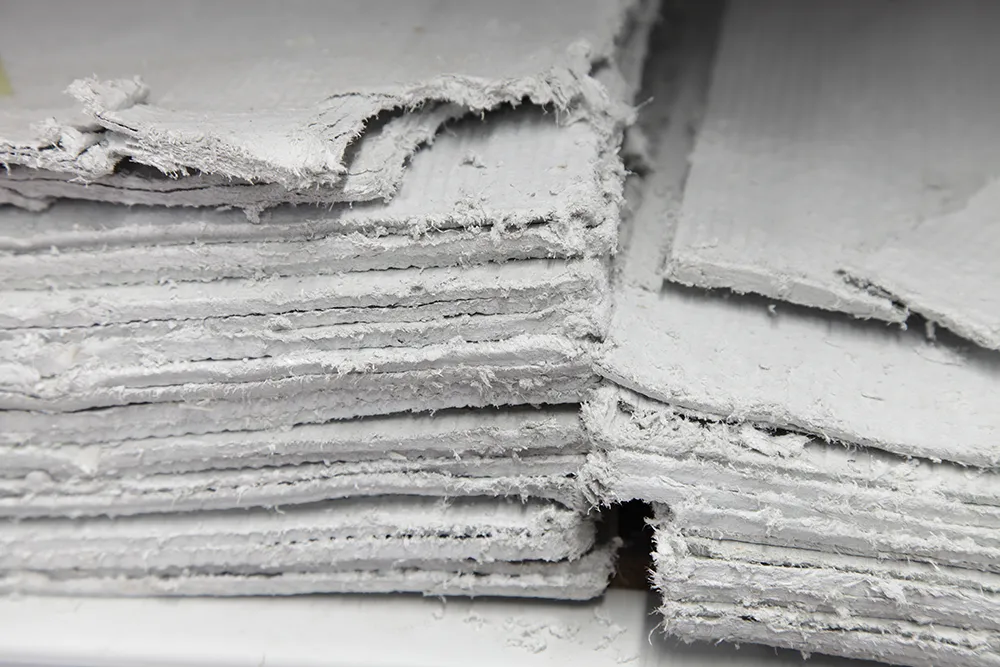Asbestos detection is an important topic, and in this article, we will discuss how you can recognise asbestos as a non-expert, how asbestos is diagnosed in the laboratory, and why timely asbestos analysis is crucial for you and your surroundings.
Asbestos – a danger in your own home
Asbestos is a naturally occurring mineral that was used in building materials in the past. However, its use is now banned due to its harmful effects on health. Despite the ban, asbestos can still be present in many older buildings, posing a potential danger to residents. Therefore, identifying asbestos to take appropriate action quickly and safely is of utmost importance. Asbestos can cause several health problems, which is why it is crucial to be careful when coming into contact with asbestos fibres. In many cases, it is advisable to seek help from experts to ensure that all necessary precautions are taken before starting work on asbestos-containing materials. The following article explains how to recognize asbestos and handle the fibres correctly.
A serious threat to health
Asbestos is a dangerous mineral whose fine fibres can easily be inhaled. These fibres can build up in the lungs, leading to serious lung diseases such as asbestosis. The symptoms often only appear years later, which is why it is essential to deal with the issue at an early stage. Asbestos was once used in many building materials but can still be present in older buildings.
As a layperson, how can one identify asbestos?
If you have come across any suspicious building material, or if you have taken over an old barn where fibrous material is slowly coming loose, or if you have recently moved into new workrooms in an old building, you might have asked yourself the question of whether and how a layperson can recognize asbestos.
Two key indicators can help you determine whether asbestos is present, but they are not a guarantee. Firstly, the date of construction of the property in which you suspect asbestos is crucial. Asbestos was primarily used between 1930 and 1999. There is a low possibility that historical buildings constructed before this time might contain asbestos. The Control of Asbestos Regulations 2012 prohibits using asbestos after 1993, which means that the construction date can strongly indicate the risk of asbestos exposure. However, it is essential to note that the certainty provided by an assessment based on the construction date is not absolute in the case of historic buildings that were not listed and were renovated or refurbished between 1930 and 1999.
On the other hand, the material’s colour can often be used as an indication to at least draw conclusions about the possibility of asbestos exposure. Whether chrysotile asbestos (white asbestos) or amphibole-asbestos fibres usually give materials a grey tone. Unfortunately, in most cases, a layperson cannot clearly determine whether a material is asbestos due to the colour cast, so if asbestos is to be reliably identified, the only option is to consult an expert or a laboratory.
When identifying asbestos, can you differentiate between a dust sample, an air measurement, and a material sample?
Detecting asbestos in several reliable ways is possible, but a search will usually reveal the three methods mentioned above. Let’s begin with the easiest and fastest analysis method: the dust sample. This method is often called a rapid asbestos test and can be conducted by anyone, including laypeople.
Dust samples and rapid tests
Dust residues are typically collected from surfaces such as door frames, window sills, or cupboards using an adhesive strip to determine if the dust in a room is contaminated with asbestos. If needed, dust can also be taken from a pile of rubble, but it’s essential to wear an FFP2 mask when collecting the sample to protect your airways from any asbestos that may be present. The measurement is always qualitative, meaning it determines whether asbestos is present. Many laboratories also provide information on the number of asbestos fibres present in the sample.
Measurement of air quality
There are two forms of asbestos measurement: dust sampling and indoor air measurement. People often confuse the latter with the former. While the dust sample only checks the presence of asbestos, indoor air measurement also determines the quality of the air. It is important to note that this measurement is usually conducted by an expert as it involves filtering the air with a measuring device to calculate the exact concentration of asbestos fibres/m³ of air. This type of measurement has both advantages and disadvantages. On the one hand, it allows the precise concentration of asbestos fibres per m³ of air to be identified, thus determining the hazard level.
A professional will conduct air measurements after remediation to ensure the safety of residents by verifying levels are below limits.
Material samples
Material samples are a widely used method to detect asbestos. The advantage of taking a material sample is that it can be done by anyone in many cases, eliminating the need for an expert and incurring no additional costs. This method provides precise information on the presence of asbestos fibres in a material. It can help anyone undertaking a major renovation or refurbishment project quickly and accurately determine whether the material to be worked on is contaminated. However, selecting the correct analysis method is crucial to ensure accuracy.
How can asbestos be recognised in the laboratory?
There are various laboratory methods and analysis procedures available for detecting asbestos. Asbestos can be examined under a polarisation microscope (PLM), but this method only allows for limited magnification of up to 50x. On the other hand, the scanning electron microscope (SEM) combined with energy-dispersive X-ray spectroscopy (EDX) allows for magnification of up to 300,000x.
It is essential that in every accredited laboratory, an interpretation of the image on an SEM image is carried out by expert personnel to ensure that the fibres shown are actually asbestos fibres. Laboratory staff are supported in this by analysing the EDX spectrum to determine which elements have been detected.
Asbestos in the world of work
Many people still work in jobs where they are at an increased risk of being exposed to asbestos. Workers in the construction industry, shipbuilding, roofing, and engineering are particularly at risk. These professions should be aware of the dangers of asbestos in the workplace and the correct protective measures. It is also crucial that companies publicise and implement their obligations and measures to protect workers.
Conclusion: Identifying Asbestos
It is almost only possible to recognize asbestos with laboratory equipment. The higher the asbestos content in the material, the easier it is to speculate whether the natural mineral fibre was used based on a visual inspection. However, only a laboratory analysis can provide reliable information. When selecting a laboratory, it is essential to ensure that the SEM method is used to detect asbestos reliably.
In general, it is essential to recognize asbestos before renovation work in older buildings to protect the health of the occupants. An inspection by a qualified expert can help to identify and eliminate potential hazards at an early stage. It is also essential to learn about the risks of asbestos and the symptoms of asbestosis so that you can act quickly if you suspect exposure. In general, it is crucial to be proactive and keep an eye on your family’s health and the environment by recognizing and removing asbestos before it is too late.
IVARIO offers a variety of asbestos testing kits using the SEM method.

